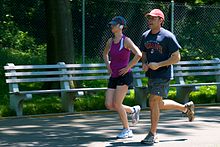Exercise

Exercise is often recommended as a means of improving motor skills, fitness, muscle and bone strength, and joint function. Exercise has several effects upon muscles, connective tissue, bone, and the nerves that stimulate the muscles. One such effect is muscle hypertrophy, an increase in size of muscle due to an increase in the number of muscle fibers or cross-sectional area of myofibrils. The degree of hypertrophy and other exercise induced changes in muscle depends on the intensity and duration of exercise.
Generally, there are two types of exercise regimes, aerobic and anaerobic. Aerobic exercise (e.g. marathons) involves low intensity, but long duration activities during which, the muscles used are below their maximal contraction strength. Aerobic activities rely on the aerobic respiration (i.e. citric acid cycle and electron transport chain) for metabolic energy by consuming fat, protein carbohydrates, and oxygen. Muscles involved in aerobic exercises contain a higher percentage of Type I (or slow-twitch) muscle fibers, which primarily contain mitochondrial and oxidation enzymes associated with aerobic respiration. On the contrary, anaerobic exercise is associated with short duration, but high intensity exercise (e.g. sprinting and weight lifting). The anaerobic activities predominately use Type II, fast-twitch, muscle fibers. Type II muscle fibers rely on glucogenesis for energy during anaerobic exercise. During anaerobic exercise, type II fibers consume little oxygen, protein and fat, produces large amounts of lactic acid and are fatigable. Many exercises are partially aerobic and anaerobic; for example, soccer and rock climbing.
The presence of lactic acid has an inhibitory effect on ATP generation within the muscle. It can even stop ATP production if the intracellular concentration becomes too high. However, endurance training mitigates the buildup of lactic acid through increased capillarization and myoglobin. This increases the ability to remove waste products, like lactic acid, out of the muscles in order to not impair muscle function. Once moved out of muscles, lactic acid can be used by other muscles or body tissues as a source of energy, or transported to the liver where it is converted back to pyruvate. In addition to increasing the level of lactic acid, strenuous exercise results in the loss of potassium ions in muscle. This may facilitate the recovery of muscle function by protecting against fatigue .
Delayed onset muscle soreness is pain or discomfort that may be felt one to three days after exercising and generally subsides two to three days after which. Once thought to be caused by lactic acid build-up, a more recent theory is that it is caused by tiny tears in the muscle fibers caused by eccentric contraction, or unaccustomed training levels. Since lactic acid disperses fairly rapidly, it could not explain pain experienced days after exercise.
Comments
Post a Comment